Seeking Legal Assistance For Transvaginal Mesh Injuries
- Last Updated: July 9th, 2024

Attorney Jessie Paluch, founder of TruLaw, has over 25 years of experience as a personal injury and mass tort attorney, and previously worked as an international tax attorney at Deloitte. Jessie collaborates with attorneys nationwide — enabling her to share reliable, up-to-date legal information with our readers.
Legally Reviewed
This article has been written and reviewed for legal accuracy and clarity by the team of writers and legal experts at TruLaw and is as accurate as possible. This content should not be taken as legal advice from an attorney. If you would like to learn more about our owner and experienced injury lawyer, Jessie Paluch, you can do so here.
Fact-Checked
TruLaw does everything possible to make sure the information in this article is up to date and accurate. If you need specific legal advice about your case, contact us by using the chat on the bottom of this page. This article should not be taken as advice from an attorney.
Key takeaways:
- Transvaginal mesh injuries can lead to complications like pain, infection, and organ damage. Victims should seek legal help from specialized attorneys well-versed in medical litigation.
- When choosing a lawyer for your case, prioritize those with a successful history of handling transvaginal mesh claims and who make you feel comfortable discussing personal health matters.
- Time is critical; consult an attorney promptly due to the statute of limitations for filing a lawsuit. Evidence of harm from the implant must be documented for legal action.
Overview of Transvaginal Mesh Injuries
On this page, we will discuss an overview of legal assistance for transvaginal mesh injuries, various symptoms of transvaginal mesh injuries, how to file a lawsuit for transvaginal mesh injuries, and much more.
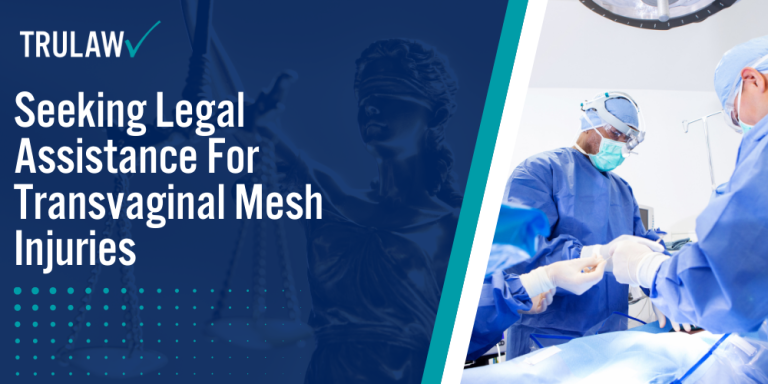
Intro to Transvaginal Mesh Injuries
The following complications have led to an increase in transvaginal mesh injuries reported:
- Erosion and Exposure: Mesh erosion into the vaginal canal, known as mesh exposure, is a common injury that can cause significant discomfort and require additional surgical intervention.
- Infection and Pain: Complications such as infections and chronic pain are frequently reported, leading to a diminished quality of life and ongoing medical challenges.
- Urinary Problems and Recurrence: Urinary difficulties and the recurrence of prolapse or incontinence are notable complications that undermine the initial goals of the mesh surgery.
- Life-Changing Negative Consequences: Some patients experience life-altering negative physical consequences, including autoimmune reactions and post-surgical infections, due to mesh complications.
Our experienced team of product liability attorneys at TruLaw estimates settlement values may reach as much as $150,000 to $400,000 based on the severity of the transvaginal mesh injuries.
Contact TruLaw using the chat on this page to find out if you qualify to seek compensation in the transvaginal mesh lawsuit today.
Table of Contents
Transvaginal Mesh Injuries: Symptoms of Pelvic Floor Disorder
Transvaginal mesh complications often manifest through pelvic floor disorders such as pelvic organ prolapse and stress urinary incontinence, leading to a range of symptoms that affect patients’ quality of life.
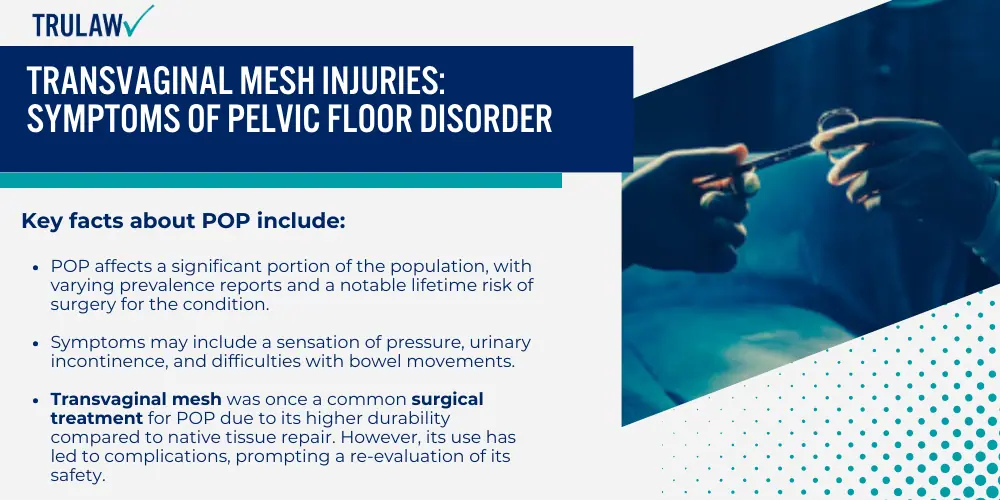
Overview of Pelvic Organ Prolapse
Pelvic organ prolapse (POP) occurs when the pelvic floor muscles weaken, causing pelvic organs to descend or press into the vaginal canal.
This can cause discomfort and urinary problems and interfere with sexual function.
Key facts about POP include:
- POP affects a significant portion of the population, with varying prevalence reports and a notable lifetime risk of surgery for the condition.
- Symptoms may include a sensation of pressure, urinary incontinence, and difficulties with bowel movements.
- Transvaginal mesh was once a common surgical treatment for POP due to its higher durability compared to native tissue repair. However, its use has led to complications, prompting a re-evaluation of its safety.
A clinical analysis of pain post-transvaginal mesh surgery offers insights into the range of symptoms experienced by patients.
Diagnosing Stress Urinary Incontinence
Stress urinary incontinence (SUI) is a specific type of incontinence in which urine leaks during physical activity, sneezing, or coughing.
The process of diagnosing SUI typically includes:
- A thorough medical history review to identify symptoms and potential contributing factors.
- Physical examinations, including pelvic exams, to assess the strength of the pelvic floor muscles.
- Urine tests to rule out infections or other causes of urinary symptoms.
- Cough stress test, where leakage is observed during coughing.
The use of surgical mesh in treating SUI has been seen as a minimally invasive yet durable option.
However, the procedure’s possible complications, such as mesh erosion and chronic pain, have led to controversy.
A detailed overview of mesh complications may inform the discussion on the best practices in diagnosis and treatment.
Common Transvaginal Mesh Injuries
Transvaginal mesh injuries can occur due to a variety of reasons associated with mesh use in pelvic surgeries.
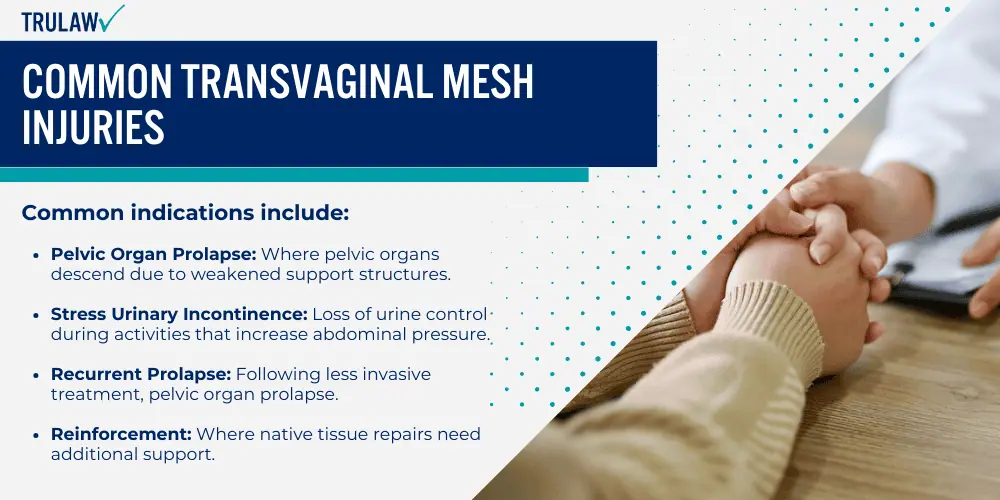
This section outlines the common complications that arise from these procedures.
Indications for Mesh Use
Transvaginal mesh is typically used to address conditions such as pelvic organ prolapse (POP) and stress urinary incontinence (SUI).
These conditions can greatly affect the quality of life and may necessitate female pelvic reconstructive surgery.
Common indications include:
- Pelvic Organ Prolapse: Where pelvic organs descend due to weakened support structures.
- Stress Urinary Incontinence: Loss of urine control during activities that increase abdominal pressure.
- Recurrent Prolapse: Following less invasive treatment, pelvic organ prolapse.
- Reinforcement: Where native tissue repairs need additional support.
Surgical Techniques
The surgical technique for transvaginal mesh placement involves making a vaginal incision through which the mesh is inserted and positioned to support the affected pelvic organs.
Surgical complications can manifest in several forms, including:
- Mesh erosion: the mesh wears away the surrounding tissue.
- Infection: the presence of the mesh can lead to infections.
- Pain: chronic pain can be associated with mesh usage.
- Dyspareunia: pain during intercourse is a possible complication.
Minimally Invasive Approaches
Minimally invasive approaches to transvaginal mesh surgery are employed to reduce recovery time and limit complications.
Key features of these techniques include:
- Small Incisions: Reducing scarring and healing time.
- Specialized Instruments: Allowing for precision during mesh placement.
- Lowered Infection Risk: Due to reduced exposure of internal tissues.
- Limited Tissue Dissection: Aiming to preserve tissue integrity and function.
Transvaginal Mesh Injuries and Complications
The surgical placement of mesh for pelvic organ prolapse can potentially lead to significant complications, two of the most concerning being vaginal mesh exposure and mesh erosion.
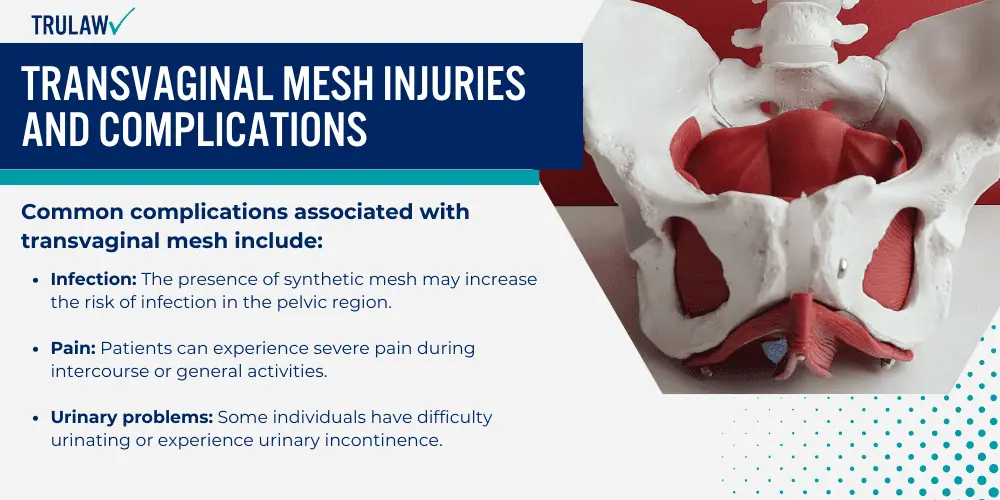
These complications may require medical intervention and can have a considerable impact on the quality of life.
Understanding Mesh Complications
Transvaginal mesh injuries and complications arise from the implantation of synthetic material designed to provide support to weakened pelvic tissues.
The complexities of these complications can vary, but some patients experience severe outcomes.
Common complications associated with transvaginal mesh include:
- Infection: The presence of synthetic mesh may increase the risk of infection in the pelvic region.
- Pain: Patients can experience severe pain during intercourse or general activities.
- Urinary problems: Some individuals have difficulty urinating or experience urinary incontinence.
- Bleeding: Abnormal vaginal bleeding has been reported in connection with mesh complications.
- Organ perforation: During the insertion process or subsequent to implantation, the mesh may perforate nearby organs, such as the bladder or bowel.
Identifying Mesh Exposure and Erosion
When it comes to mesh exposure and erosion, timely diagnosis is critical to manage symptoms effectively and avoid further complications.
These conditions are distinguishable by the presence of mesh through the vaginal epithelium or into surrounding organs.
Signs and symptoms indicative of mesh exposure and erosion include:
- Visible mesh: The mesh may become visible through the vaginal lining.
- Vaginal discharge or bleeding: These are common signs that may indicate mesh exposure or erosion.
- Recurrent infections: These could suggest that the body is reacting adversely to the mesh.
- Pelvic or vaginal pain: This could be a sign that the mesh is eroding into surrounding tissues.
- Pain during intercourse: This can be an indicator of mesh-related problems in the vaginal wall.
Managing Transvaginal Mesh Injuries
Transvaginal mesh injuries require careful assessment to determine the appropriate management strategy, which may include conservative treatment or surgical intervention.
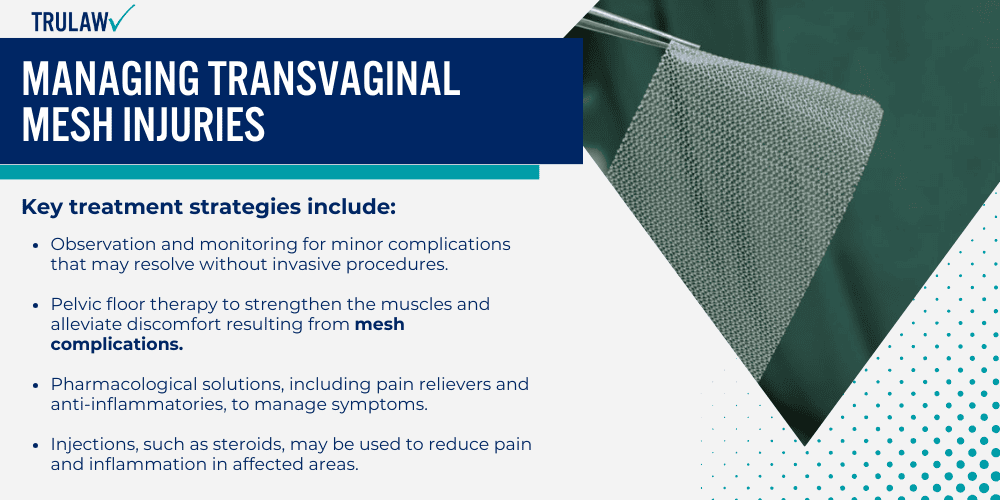
Treatment Strategies
When addressing transvaginal mesh injuries, multiple treatment strategies come into play, and the choice depends on the severity and nature of the complications.
Treatment methods vary from non-invasive approaches to more complex surgical procedures.
Key treatment strategies include:
- Observation and monitoring for minor complications that may resolve without invasive procedures.
- Pelvic floor therapy to strengthen the muscles and alleviate discomfort resulting from mesh complications.
- Pharmacological solutions, including pain relievers and anti-inflammatories, to manage symptoms.
- Injections, such as steroids, may be used to reduce pain and inflammation in affected areas.
Mesh Revision and Removal
In cases where mesh excision or complete mesh removal surgery is necessary, surgical intervention becomes inevitable, particularly for serious complications.
The factors taken into account for surgical options are:
- Degree of mesh exposure or erosion and associated symptoms
- Involvement of surrounding tissues and organs
- Patient’s overall health and risk factors for surgery
- Previous interventions and their outcomes
Mesh revision and removal must be conducted by an experienced surgeon trained in female pelvic medicine and reconstructive surgery to minimize risk and improve outcomes.
Legal and Regulatory Considerations of Transvaginal Mesh Injuries
The landscape of legal and regulatory issues surrounding transvaginal mesh injuries has evolved significantly, reflecting concerns over patient safety and the outcomes of mesh implant surgeries.
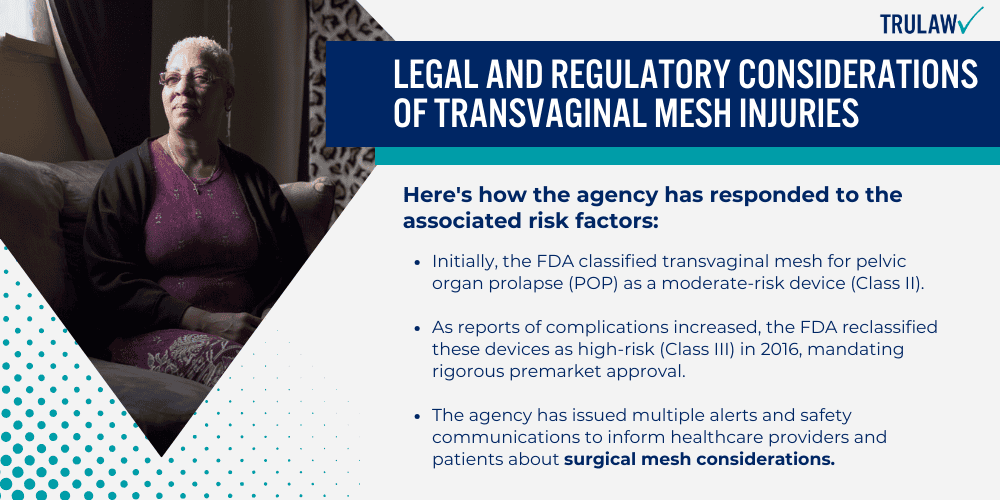
FDA Regulations
The U.S. Food and Drug Administration (FDA) plays a pivotal role in overseeing the safety of medical devices, including urogynecology surgical mesh implants.
Here’s how the agency has responded to the associated risk factors:
- Initially, the FDA classified transvaginal mesh for pelvic organ prolapse (POP) as a moderate-risk device (Class II).
- As reports of complications increased, the FDA reclassified these devices as high-risk (Class III) in 2016, mandating rigorous premarket approval.
- The agency has issued multiple alerts and safety communications to inform healthcare providers and patients about surgical mesh considerations.
- Companies manufacturing surgical meshes are now required to conduct post-market surveillance studies to monitor the devices’ performance over time.
Considerations of surgical mesh regulations entail assessing the adequacy of clinical trials, post-market oversight, and the FDA’s reactive measures to emerging safety data.
Patient Litigation Cases
Litigation concerning transvaginal mesh injuries has become a critical component of the legal discourse surrounding these medical devices.
Key developments in the legal arena include:
- Plaintiffs alleging injury from mesh implants have filed numerous lawsuits, leading to multi-million dollar settlements and jury verdicts for compensatory and punitive damages.
- Legal arguments often focus on risk factors that were not adequately disclosed to patients, alongside allegations of design defects and insufficient testing.
- Case precedents and outcomes have varied, with some courts finding in favor of the defendant manufacturers on the grounds of preemption, due to the FDA’s regulatory authority over medical devices.
- There has been an establishment of multidistrict litigation (MDL) to efficiently manage the large volume of cases alleging similar harms from surgical mesh devices.
These legal actions underscore the need for transparency in the communication of risks and the responsibility of medical device manufacturers to ensure the safety of their products.
Living with a Transvaginal Mesh Injury
Individuals with transvaginal mesh injuries often experience a complex set of chronic symptoms that significantly affect their daily lives.
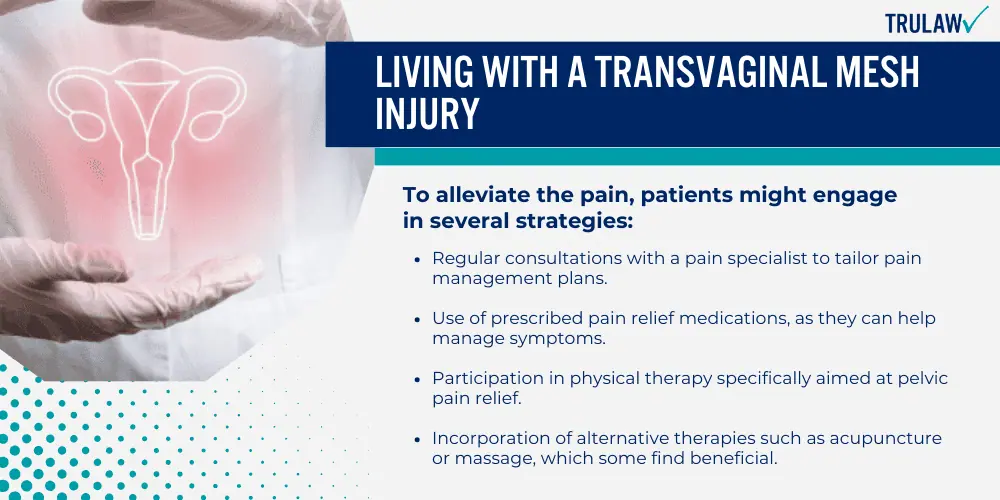
These symptoms can include chronic pelvic pain, urinary problems, bladder neck issues, and voiding dysfunction.
Coping with Chronic Pelvic Pain
Chronic pelvic pain is a prevalent issue for those living with a transvaginal mesh injury.
The pain can be constant or intermittent, affecting one’s physical, emotional, and social well-being.
To alleviate the pain, patients might engage in several strategies:
- Regular consultations with a pain specialist to tailor pain management plans.
- Use of prescribed pain relief medications, as they can help manage symptoms.
- Participation in physical therapy specifically aimed at pelvic pain relief.
- Incorporation of alternative therapies such as acupuncture or massage, which some find beneficial.
Long-Term Management
The long-term management of transvaginal mesh injuries often involves a multidisciplinary approach to address the various complications that may arise.
Key components of this management strategy include:
- Regular medical assessments to monitor for potential complications and to adapt treatment plans accordingly.
- Urodynamic tests to assess bladder and urethral function for individuals with voiding dysfunction.
- Adhering to a personalized physiotherapy program to strengthen pelvic muscles and alleviate symptoms.
- Surgical interventions, in some cases, to remove or correct the mesh if it is causing significant issues.
- Psychological support for chronic health issues can have a profound impact on mental health, making counseling a valuable component of care.
- Lifestyle modifications, such as dietary changes and bladder training exercises, may also play a crucial role in managing urinary problems.
Frequently Asked Questions
-
What complications can arise years after a bladder mesh sling procedure?
Years after a bladder sling procedure, patients may experience complications such as mesh erosion into surrounding tissues, recurrent infections, urinary problems, and pelvic pain.
Additionally, some individuals may face issues with sexual dysfunction due to mesh complications.
-
How can you identify symptoms of mesh erosion?
Symptoms of mesh erosion include abnormal vaginal discharge, vaginal bleeding, pain during intercourse, and visible mesh through the vaginal lining.
If experiencing any of these symptoms, it’s crucial to consult a healthcare professional promptly.
-
What legal options are available for individuals with vaginal mesh complications?
Individuals with vaginal mesh complications can explore legal avenues by consulting specialized attorneys to determine if they have a case for medical malpractice or product liability.
Legal action can often lead to compensation for medical costs, pain and suffering, and other related damages.
-
Are there alternatives to using mesh for treating prolapse conditions?
Alternatives to using mesh for prolapse include pelvic floor therapy, pessary devices, and traditional pelvic organ prolapse surgery without mesh.
Each alternative has its pros and cons and should be discussed thoroughly with a healthcare provider to determine the most suitable option.
-
Can the presence of pelvic mesh lead to chronic pain?
The presence of pelvic mesh can lead to chronic pain for some individuals.
This pain may be due to tissue inflammation, nerve entrapment, or mesh contraction, significantly impacting the patient’s quality of life.
-
What is the standard treatment approach for mesh erosion?
The standard treatment for mesh erosion typically involves surgical intervention to remove the exposed mesh and repair the affected tissue.
In select cases, conservative management like estrogen cream or observation may be considered if the symptoms are mild and not progressing.

Experienced Attorney & Legal SaaS CEO
With over 25 years of legal experience, Jessie is an Illinois lawyer, a CPA, and a mother of three. She spent the first decade of her career working as an international tax attorney at Deloitte.
In 2009, Jessie co-founded her own law firm with her husband – which has scaled to over 30 employees since its conception.
In 2016, Jessie founded TruLaw, which allows her to collaborate with attorneys and legal experts across the United States on a daily basis. This hypervaluable network of experts is what enables her to share reliable legal information with her readers!
You can learn more about the Transvaginal Mesh Lawsuit by visiting any of our pages listed below:
Here, at TruLaw, we’re committed to helping victims get the justice they deserve.
Alongside our partner law firms, we have successfully collected over $3 Billion in verdicts and settlements on behalf of injured individuals.
Would you like our help?
At TruLaw, we fiercely combat corporations that endanger individuals’ well-being. If you’ve suffered injuries and believe these well-funded entities should be held accountable, we’re here for you.
With TruLaw, you gain access to successful and seasoned lawyers who maximize your chances of success. Our lawyers invest in you—they do not receive a dime until your lawsuit reaches a successful resolution!
Do you believe you’re entitled to compensation?
Use our Instant Case Evaluator to find out in as little as 60 seconds!
Camp Lejeune’s water contamination issue spanned several decades starting in the 1950s. Exposure to these chemicals has been linked to various serious health issues, including cancer, organ diseases, and death.
Research is increasingly suggesting a link between the use of Tylenol during pregnancy and the development of neurodevelopmental disorders, such as autism and ADHD, in infants.
Legal action is being taken against manufacturers of Aqueous Film-Forming Foam (AFFF), a chemical used in fighting fires. The plaintiffs allege that exposure to the foam caused health issues such as cancer, organ damage, and birth and fertility issues.
Here, at TruLaw, we’re committed to helping victims get the justice they deserve.
Alongside our partner law firms, we have successfully collected over $3 Billion in verdicts and settlements on behalf of injured individuals.
Would you like our help?


